Podium Image Editor Documentation
SketchUp 202x Mac Apple Silicon processeor users. Please read here if your Podium Image Editor is not opening.
PIE was created so that Podium users apply quick post processing or image editing to Podium rendered images without ever leaving SketchUp. Post processing means making changes to the bitmap image created by Podium. For example, editing the light levels, brightness, cropping the image, adding a background to alpha transparent image, adding an overlay and blending are post processing or image editing features.
To do any post processing, previously, you needed a good image editor like Photoshop. PIE makes it easy to do much of the post processing inside SketchUp and in fact from the Podium Rendering Manager or OOPR.
See also the tutorial video PIE video tutorial. The video tutorial is slightly dated but explains most of the features in PIE.
Read here to obtain information about new PIE features available in SU Podium New features in PIE that are not explained on this page.
How to use PIE
Information about all of Podium Image Editor's features is contained in the following tabs:
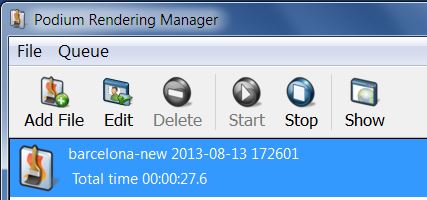
You can launch PIE from the Podium Render Manager or OOPR after you have rendered an image. Highlight the rendered image name from OOPR and click on Edit.
You can also launch PIE from the SU Podium V2 Plus Tools menu. This is an independent way of starting up PIE. Once PIE is opened, use the Open file menu to load up an image you want to edit.
Cancel: Podium Image Editor (PIE) does not have an undo button to undo adjustments and filters that you may have invoked. However, edits are not finalized until you actually press the apply button. The Cancel button will cancel any operations that you have selected and invoked.
Apply: The apply button will apply the edits you have made and can not be Undone. However, as long as you save the image using a different file name, you will not accidently alter the original rendering image permanently.
Save: Press save when you are ready to permanently save your modifications. Remember, it is considered a best practice to save your edited file under a new file name, so that you can go back to the original render if you need it.

A color histogram is a visual tool to display how the RGB pixels are distributed in the image. It helps you see the composition of the image in terms of color and light tones. It can reveal more information than what you see in your image with your eye. The histogram updates after each modification.
The Auto Level button will attempt to even out the darkest areas and lightest areas with the midtones. You can use Auto Level as a start point to adjust the lighting in the rendered image.
Use the light level sliders to adjust the lighting manually. The light Levels slider can be used to correct dark areas, midtones, or excessively light areas of the images. This is a great tool that will save you a large amount of re-rendering time. Using the light level sliders manually is typically more effective than the Auto Level button.
Note: Select Cancel to reset to the original light levels. If you select Apply, you will permanently alter the image. If you do select Apply, make sure you Save the image using a unique name.
Color balance is an indispensable tool when it comes to matching general color of a render image to a background, getting rid of the blue tint of some exterior render, or adding more of a color to the whole image.
You may need to click on Cancel if you are making light level modifications to access the Color features.
There are three sliders, one for each RGB value. Moving the sliders away from the middle position will intensify the color of the whole image. If your image looks too green for instance, simply move the Green slider to the left until it looks more balanced. Accordingly, if you image looks too blue like many exterior renders, move the blue slider to the left giving the render a more yellow tint.
These slider will help you bring more or less overall light into your rendering easily. Brightness and contrast slider can be easier to use than the level slider, but they offer less control. They apply changes to the entire image and not just to particular tones.
Moving the brightness to the right will add more light. The more you add the less contrast the image will have. Move the contrast slider to the right to add more contrast. You will notice that boosting those values will quickly make the image grainy.
The blur slider will make the image look softer. It can be used to slightly attenuate noise. But it will make all edges more blurry.
On the other hand, the sharpen slider will make all the edges more visible. It will also bring out the grain (noise) in the image.
There is now a "Defringe" slider in the Background tab, which is used to clean up the edges of Podium images rendered with a transparent alpha channel.
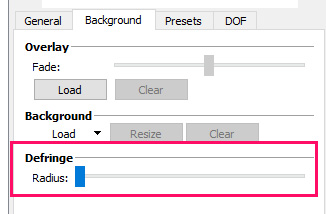
This is not always necessary, however transparent images (often those containing a lot of vegetation) sometimes end up with a noticeable "fringe" along the edge of the alpha channel.
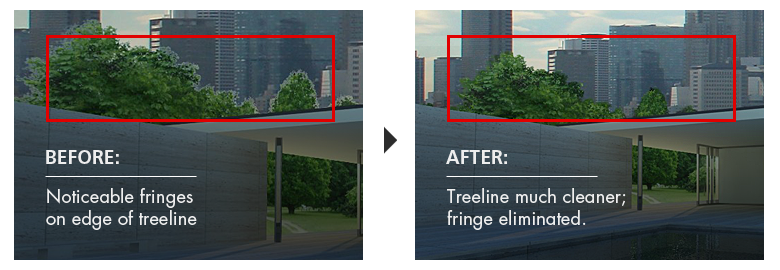
Simply adjust the defringe slider until you see the fringes on your image start to disappear, click apply, and save.
Podium Image Editor can now read and load .hdr files. This makes two things possible:
- .HDR files can be loaded as background images for your Podium renders.
- If you use the .hdr format to create a render in Podium, you can now load and edit that image in PIE.
.HDR in PIE has two limitations:
However, you cannot save to .HDR from Podium Image Editor. If you load and edit an .HDR render in PIE, you will only be able to save that image as .jpg or .png. PIE cannot re-write an hdr file.
- PIE cannot convert .hdr to spherical panorama. If you plan on uploading and converting your image with the Podium Panorama server, please use .JPG or .PNG.
Vignetting will alter the periphery of the image. Negative value will make the perimeter of the image darker and positive value will make it brighter.
Hue shifts all the colors of the image and saturation can boost or attenuate them. If you want to make the image black and white, simply move the saturation slider all the way to the left.
Primary function of this filter is to overlay non photo-realistic SketchUp images over or under the Podium rendered image. The effect is to bring out the edge lines from the SketchUp image and blend this with the Podium image.
Overlay will blend two images and this is an effective way to blend a SketchUp Exported image with the Podium rendered image. The two overlayed images must be the same resolution for this feature to work.
You can try this by exporting a SketchUp model to a 2D image using SketchUp’s Export, 2D Graphic command.
Then click on the Load Overlay and select the SketchUp generated image. Move the overlay slider to blend the two images. This way you can blend the obvious SketchUp line edges with Podium's photo-realistic image.
This is also explained visually in the PIE video tutorial. The video tutorial is slightly dated but explains most of the features in PIE
Read here to obtain information about new PIE features available in SU Podium New features in PIE.
Read a step by step tutorial on creating a line overlay Line overlay tutorial
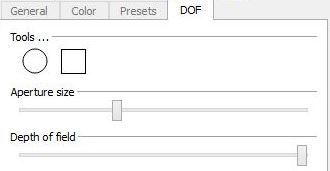
Although named DOF, this effect is similar to a Tilt-Shift function. This is where you can choose the sharp region of an image in PIE with either a ellipse or rectangle shaped aperture and the amount of blur for the unsharp regions. The blur is controlled by the size and intensity of the aperture as well as the Depth of Field slider.
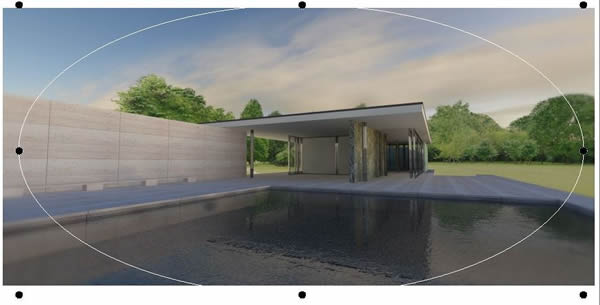

The curves tool (pictured right) gives users a more precise means to adjust brightness, contrast, and value distribution in an image.
Unlike the simpler brightness/contrast slider, Curves allows you to target specific regions of a render based on the region of the graph you are manipulating.
More information on operating the curves tool can be found here.
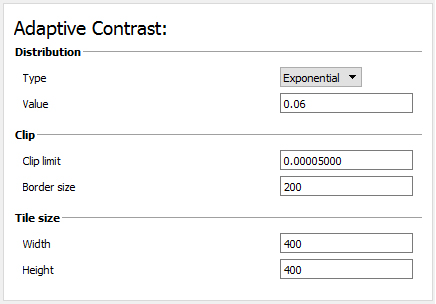
Adaptive contrast is a tool in the Advanced tab, which uses adaptive histogram equalization (AHE) to improve contrast in a render.
Instead of applying a global contrast adjustment to the entire image, the adaptive method divides the image into regions/tiles and redistributes lightness values based on a unique histogram for each section. Therefore it is suitable for improving local contrast, improving local contrast and enhancing edge definition in each region of the render.
A deeper explanation and demonstration of the adaptive contrast tool can be found here.

The history drop-down maintains a change-log and allows you undo changes to a precise point in the editing process. However once the “Apply” button is clicked, history is cleared and you will no longer be able to reverse changes using the “History” or “Cancel” buttons.
In this case, you would need to close the file and reload an older version from the OOPR or manually from the file menu of the Podium Image Editor. The History log does not work with Preset filters.
Load Background Options

Load a background from a local folder, or choose one from the Podium Image Editor Library. You must first render your image with Transparet on before you can add backgrounds.
Podium Image Editor Background Library: This is a web based Podium Image Editor library that has several hundreds images in various categories that you can use. Cadalog will be adding to this image library periodically.
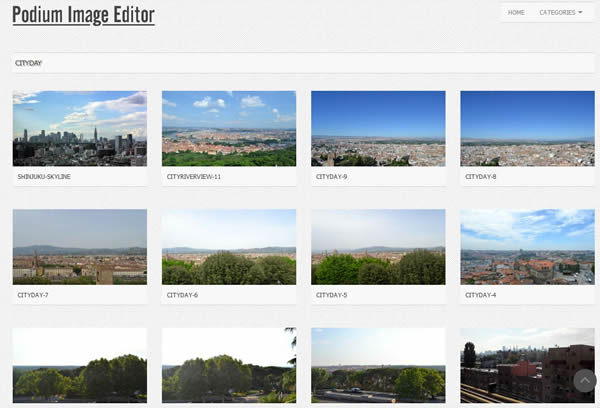
If you use the image library, select the image and use the magnify glass and increase the image size. Then right click on the image. You will see an option to Set background. By selecting this option, the image will be loaded into PIE as the background. Make sure that you have an alpha transparent image loaded in PIE before adding background images.
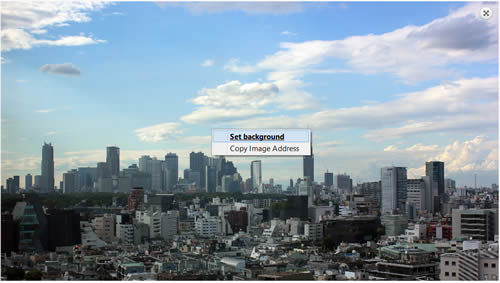
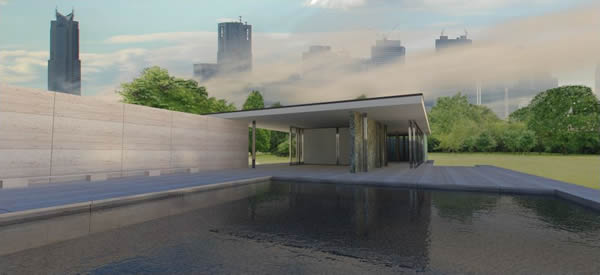
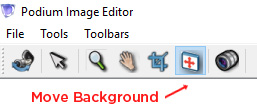
Moving background images: Moving background images is now much easier than in previous PIE versions. Just select Move backgrounds from the Tools menu and grab the background image.
Resize background images:

Background images can easily be resized by percent or an exact pixel amount.
